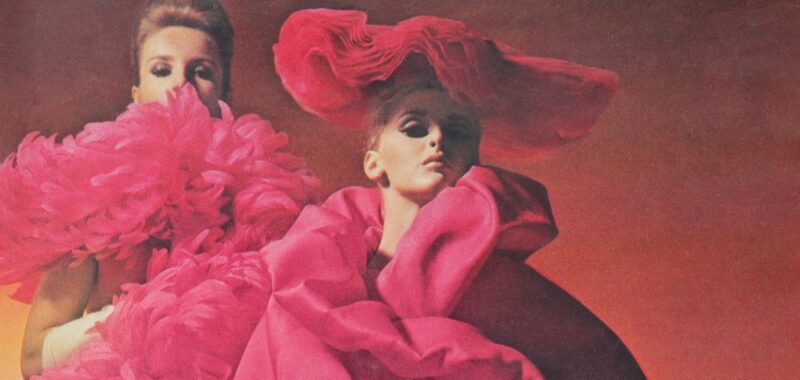Mention of Balenciaga means “Demna” to millions, but the house’s namesake founder Cristóbal Balenciaga is in sharper focus in a new book.
“Balenciaga — Kublin a Fashion Record” is chockful of images by the late fashion photographer and filmmaker Tom Kublin. Cowritten by his daughter Maria Kublin and Ana Balda, the Thames & Hudson release documents the lensman’s career and his creative alliance with the notoriously camera-shy designer during his post-war heyday in Paris in the 1950s and the 1960s. Couture shoots, fittings and magazine covers are among the 140-plus images and film stills in the tome.
There are also glimpses of Balenciaga tweaking models’ attire in his atelier before presentations. The Swiss-born Tom Kublin divided his professional life between Zurich and Paris after World War II. Contrary to the customary fashion photos of that time that diluted the innovation and the technical skills of haute couture, Kublin shot images that magnified Balenciga’s expertise. He also photographed each of Balenciaga collections for copyright protection, as was then the norm. Starting in the early 1960s, his work includes the filming of Balenciaga’s collections.
Reached at home in Amsterdam Thursday, Maria said the book was the logical thing to do, following the 2022 exhibition about the working relationship between Balenciaga and her father at the Balenciaga Museum. Miren Vives, head of the Cristóbal Balenciaga Museum, also contributed.

A fashion shot by Tom Kublin.
Photo by Tom Kublin/Courtesy Courtesy Abraham Textile Archive, Swiss National Museum, Zurich
Despite a fear of flying, Maria plans to travel to California from Europe later this month for “Balenciaga Through the Lens of Tom Kublin,” a cultural event in Santa Barbara that is being organized by the Couture Pattern Museum in conjunction with the University Club of Santa Barbara. Scheduled for Nov. 12 at the University Club, the gala will feature a talk by Maria about her father. Her father’s work with Balenciaga could be a reminder of the importance of quality in fashion versus shock, which she feels is more common now.
The event will give greater context to Kublin’s career, his place in the artistic milieu of the European avant-garde, and his working relationship with Balenciaga. The two men worked together for 19 years, and that alliance would have been longer, had Kublin not passed away at the age of 42 in 1966.
“My father was a bit younger than Balenciaga, so perhaps Balenciaga saw him as a protégé. In the beginning, he took my father to museums to have a look at [Francisco] Goya to get a feeling for how clothes were depicted [in his art] and how he could achieve that with light, etc. That was very inspiring for my father, who was very eager to take it all in and to develop a style that Balenciaga really liked as well,” Maria said.

Fashion was the photographer’s specialty.
Photo Courtesy Maria Kublin
The museum’s founder, Cara Austine-Rademaker, said Balenciaga’s hometown of Getaria, Spain, is similar to Santa Barbara in her mind, due to the latter’s Spanish and rural influence. Just as Balenciaga drew from studying the garments of royalty, namely the Marquesa de Casa Torres to hone his skills, the Couture Pattern Museum took the same tract to provide access to students, seamstresses and fashion designers, who like Balenciaga lacked the access that cities offer, she said.
The museum also has “so many patterns” in its archives from Courrèges, Hubert de Givenchy, Emanuel Ungaro and other people, who were “his disciples and students like a creative father.” The show also spotlights the artistry of Kublin whose work is not widely known yet influenced fashion. “We would not know Balenciaga as the Balenciaga without Tom Kublin’s eye,” Austine-Rademaker said.
Launched in 2022, the little-known by-appointment museum has held six exhibits including a recent one as a salute to what would have been James Galanos’ 100th birthday, which included some of his patterns and reconstructed versions from his patterns. “We do that to verify how these patterns can play a role in fashion preservation in the future. Maybe it’s a little premature, but what about in 100 or 200 years, when these museums are no longer giving anyone access, because eventually cloth decays and you have to be so delicate in how you handle, treat and study them?” Austine-Rademaker said.
In addition, the few resources for pattern archives such as the Los Angeles County Museum of Art, the University of Rhode Island and Central Saint Martins College of Art are not couture-focused and are less accessible to non-researchers especially those in remote places, according to Austine-Rademaker. The Couture Pattern Museum’s holdings start with a 1921 Lanvin one, but the majority is from “the golden age of couture” from the late 1940s through the 1950s and 1960s.

Tom Kublin, the hairdresser Christian and Ramón Esparza, Cristóbal Balenciaga’s right-hand man in 1958.
Photo Courtesy Maria Kublin
The collection is sparse from then on, since starting in the early 1970s the sewing industry mirrored the shift to ready-to-wear and away from couture. “They were democratizing the brand names but not the craftsmanship any longer. What’s so brilliant about these couture patterns is they come with instructions and most of these dresses have to be made by hand. They are the exact line-by-line creations that the designers issued,” she said. “Once ready-to-wear started to infiltrate our society, people started to value brands and brand names more than the craftsmanship.” (The museum plans to digitalize everything.)
Having been invited to attend one of Demna’s runways shows for Balenciaga in Paris, Maria said, “I must say he is very talented. It was really beautiful — not everything, obviously. The concept is very smart but at the same time, it is not anything that is aligned with Cristóbal Balenciaga. It takes away from the essence of Balenciaga and his own talent. He [Demna] is known for his big Crocs and Ikea bag, and that takes away from his craftsmanship.”

